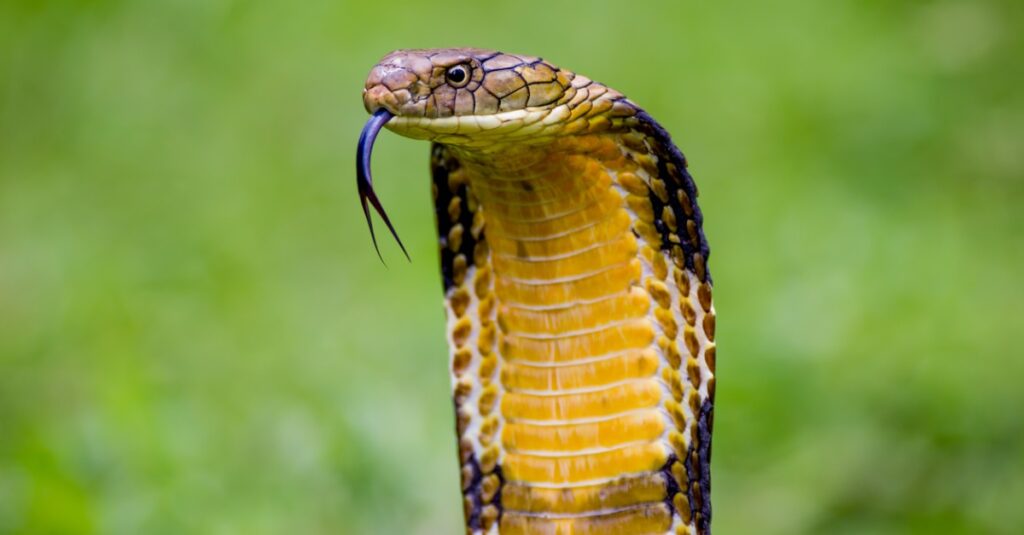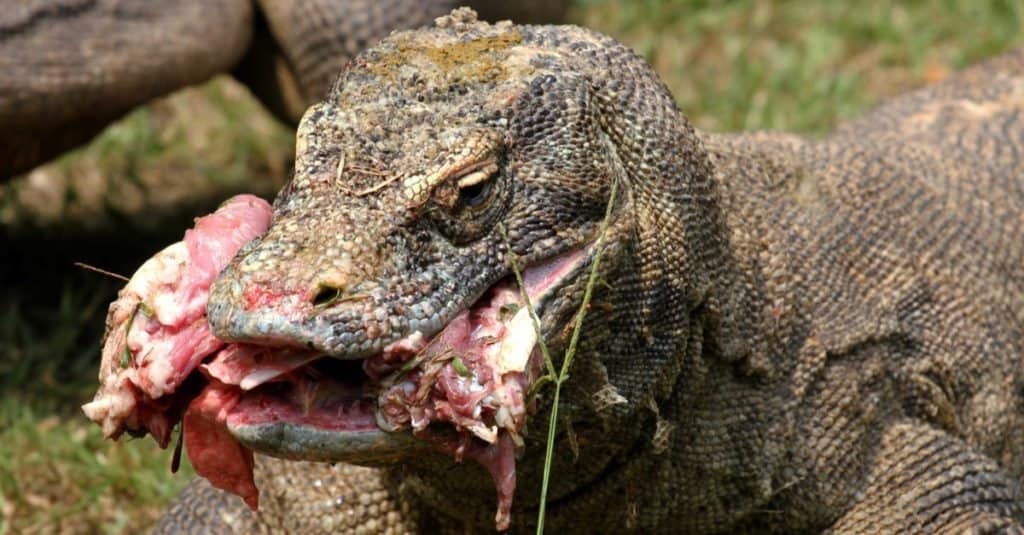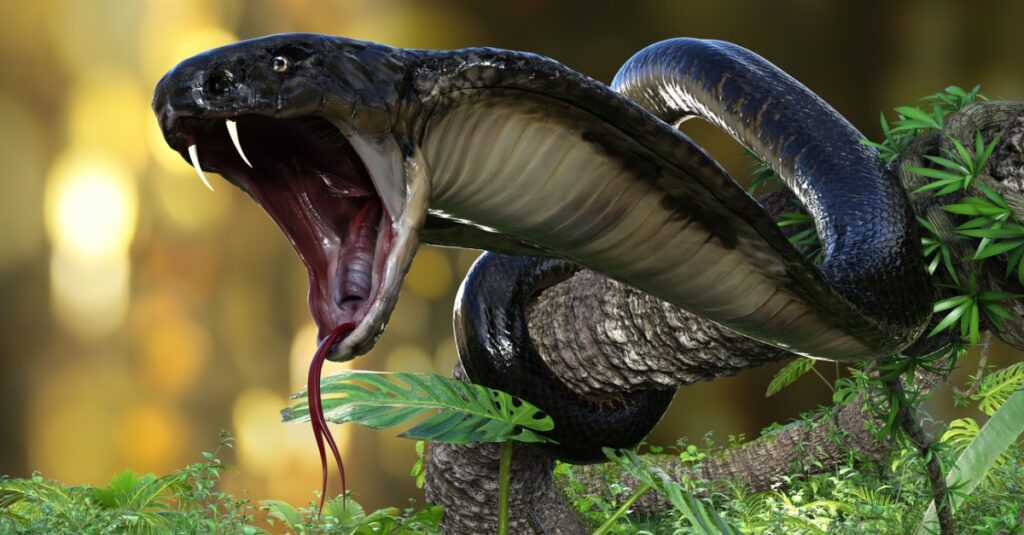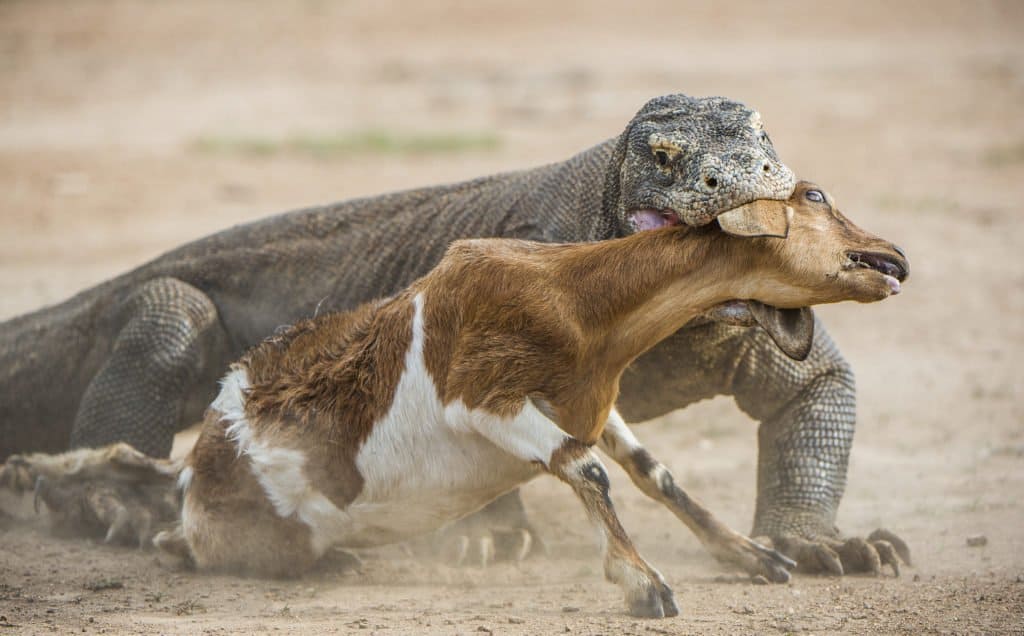Komodo dragons are large monitor lizards that ambush, pursue, and kill a wide variety of animals throughout South East Asia, including humans from time to time. They share lands with many other animals. Among their fellow reptiles in this part of the world is a serious threat to humans: the king cobra. What happens when the largest venomous snake meets the nimble and deadly Komodo dragon? Discover the winner of a Komodo dragon vs king cobra fight!
Comparing a Komodo Dragon and a King Cobra

| Komodo Dragon | King Cobra | |
| Size | -Weight: 150lbs – 300lbs -Length: 6ft-10ft | -Weight: 10lbs-15lbs –Length: 10lbs-19ft |
| Speed and Movement Type | -11 mph -Crawling motion | -12 mph – Slithering along the ground |
| Bite Power and Venom | –Weak bite power, roughly 100-300PSI – 60 teeth – Razor-sharp, serrated teeth | – Powerful venom that can disable and kill enemies – One of the most venomous snakes in the world. |
| Senses | – Good eyesight – Use their tongues to “smell” their environment and find prey from miles away – Poor hearing | – Uses Jacobson’s organ to sense chemicals in its surroundings. – Can use infrared vision to locate prey – King Cobras can hear a narrow range of low sounds |
| Defenses | – Hard skin with strong scales that are reinforced with bony deposits. – Speed | – Good camouflage – King Cobras can escape in narrow areas – Scary threat display wards off attacks |
| Offensive Capabilities | – Possibly venomous – Sharp teeth lead to exsanguination in victims – Sharp claws hold prey in place | – Will lift the front of its body several feet from the ground and then strike, allowing it to deliver venom in the vital areas. – Long fangs deliver venom. |
| Predatory Behavior | – Ambush predators – Tries to knock down and bite vital areas on prey, typically the neck. | – Ambush predator that lies in wait and attacks other animals and reptiles, including other snakes. |
The Key Factors in a Fight Between a Komodo Dragon and a King Cobra

The king cobra is the longest venomous snake.
©iStock.com/takeo1775
How can we decide the winner of a fight that has rarely occurred and not been recorded? That’s a fair question. Instead of pitting two creatures against each other, we’re going to examine the key factors in a Komodo dragon vs king cobra fight. To begin, we’re going to consider the physical features of the two creatures and see which has the advantage in areas like size, speed, and offensive power. Then, we’re going to add in the combat prowess of the two animals. With all that data, we will show you which creature is most likely to walk or slither away from the battle.
Physical Features of a Komodo Dragon and a King Cobra

Komodo dragons are agile, scaly, and powerful creatures.
©Yudi S/Shutterstock.com
The Komodo dragon and king cobra are interesting in that they are both the largest of their kind. The Komodo dragon is the biggest and deadliest monitor lizard, and the king cobra is the largest venomous snake in the world. We are going to look at the size, speed, senses, and other features of these animals and see which is better suited to win a fight.
Komodo Dragon vs King Cobra: Size
A Komodo dragon is larger than a king cobra in terms of sheer size and weight. Although they only stand a few feet off the ground, a Komodo dragon weighs up to 300 lbs and grows up to 10ft long. The largest Komodo dragon ever recorded tipped the scales at 365 pounds! The largest king cobra can grow up to 19 feet long, but it weighs about 15 pounds on average.
The Komodo dragon has an advantage in terms of size.
Komodo Dragon vs King Cobra: Speed and Movement
Speed can mean the difference between becoming a meal or escaping with one’s life. Komodo dragons and king cobras have very similar top speeds, with the former reaching 11mph and the latter slithering at a speedy 12mph over very short distances.
The Komodo dragon is slower than the king cobra, but it can maintain its speed longer, so it gets the advantage.
Komodo Dragon vs King Cobra: Bite Power and Teeth
The Komodo dragon has a rather weak bite, but its teeth are so sharp and numerous that they will tear open its prey and simply wait for it to bleed to death. King cobras have incredibly potent venom that kills thousands of people every year and many more animals.
Both animals are deadly, but the bite of a King cobra is much more difficult to survive.
Komodo Dragon vs King Cobra: Senses
Both of these creatures rely on their hunting instincts to kill their prey. The Komodo dragon has good eyesight as well as an amazing taste of “smell” that helps them find enemies from far away. King cobras have poor hearing, great eyesight, and a similar sense of smell to the Komodo dragon.
All in all, the king cobra’s sense of vision is the biggest discernable difference, so they have the advantage.
Komodo Dragon vs King Cobra: Physical Defenses
The defenses of a Komodo dragon include its strong skin and speed. A king cobra is adapted for hiding and scaring off enemies with its threat display. Their threat display includes standing nearly eye-level with various animals and spreading its hood.
The Komodo dragon’s scaly skin keeps them safer than a cobra’s hiding abilities.
Combat Skills of a Komodo Dragon and a King Cobra

King cobras rely on their venom to kill their enemies.
©iStock.com/mrjo2405
The Komodo dragon is a straightforward animal. It spots prey and ambushes it with tremendous speed and vicious bites. King cobras are also ambush predators but they are more subtle in their opportunistic attacks. Both creatures are incredibly deadly, so we will not assign a winner to this aspect of the comparison. Instead, we’ll explore it in greater detail in the final sections.
Prey
Komodo dragons are the dominant predators on their home islands, meaning they can eat whatever they want, and they do. These lizards are known to eat anything from smaller dragons to already dead animals, and even large water buffalo. Komodo dragons are known to eat snakes as well. King cobras, on the other hand, are known to feed on large, non-venomous snakes such as rat snakes, or venomous species, such as sea kraits. The two reptiles have very different key prey, making it difficult to tell if this makes a difference in their fighting capabilities.
What Are the Key Differences Between a Komodo Dragon and a King Cobra?

Komodo dragons are heavier than king cobras and they live in fewer places.
©Sergey Uryadnikov/Shutterstock.com
Komodo dragons are monitor lizards and king cobras are snakes. The biggest differences between a Komodo dragon and a king cobra are morphological ones such as the Komodo dragon having legs to crawl with instead of slithering. King cobras are longer than Komodo dragons, but Komodo dragons weigh much more than the relatively narrow snake. Although both reptiles live in Asia, Komodo dragons only live in a few locations. King cobras are much more numerous and widespread than Komodo dragons.
Are Komodo Dragons Venomous?
The bite of a Komodo dragon is venomous and has been known to lead to fatalities in humans because it prevents blood clotting. Their saliva is also full of several strains of infectious bacteria. Oftentimes, if their prey escapes, it will die of an infection in only a few days. While their venom is not as potent and fast acting as a King Cobra, it is deadly nonetheless.
Along with the risk of venom, these large lizards have sharp teeth and claws that can cause deep wounds with extreme pain. In Indonesia, there are many documented deaths from Komodo dragons, making them a source of fear and respect in the culture. Although the chances of being attacked or killed by one are slim, people still take precautions as a measure of caution.
Who Would Win in a Fight Between a Komodo Dragon and a King Cobra?

The Komodo dragon takes down tough prey, but it might die killing a king cobra.
©Sergey Uryadnikov/Shutterstock.com
A Komodo dragon would win a fight against a king cobra. Both creatures are ambush predators, but the king cobra must rely on its venom to kill its enemy before it is attacked and killed. Usually, that works, but we must remember that the Komodo dragon also has very tough skin, and it might be difficult for a cobra to bite and envenomate the lizard.
The fight would play out with one of the creatures, probably the king cobra, noticing the Komodo dragon. If prompted to fight, the king cobra would hold several feet of its head area off the ground to give it more length to strike and to intimidate the enemy. The Komodo dragon, being more agile, would probably try to attack the snake’s tail area, inflicting severe bites that might inject saliva-borne venom into the wounds.
Bleeding and injured, the king cobra would need to launch an attack since it is too slow to get away. From here, a few outcomes are likely. Either the Komodo dragon uses its bite to make the snake bleed out, the snake bites the Komodo dragon, and the latter viciously attacks the head of the snake, or the two inflict attack after attack on each other.
The cobra will either lose the fight outright or have a pyrrhic victory, dying to deliver a fatal bite on the lizard. Either way, the snake will be in the lizard’s belly by the time the latter dies from venom. Unless the snake landed a bite to a vital area and quickly killed the lizard, it will lose.
Conservation Status and Threats
Komodo dragons are listed as Endangered on the International Union for Conservation of Nature’s Red List due to multiple threats from human activities. Habitat destruction, primarily caused by agriculture, has reduced their range and, with it, their population numbers. Additionally, overhunting of their prey species, such as deer and wild boar, by humans is having a major impact on Komodo dragon populations. It is estimated that fewer than 5000 Komodo dragons remain in the wild. Some reports suggest that there may be as few as 700 left living on the island of Komodo alone. Other islands where they have previously been found have no recorded sightings in recent decades, indicating further declines in population numbers across its former range. These critically low numbers make this species one of the most endangered lizards in the world today.
The International Union for Conservation of Nature has listed the king cobra as vulnerable to extinction due to human activities, such as habitat destruction, over-collection for the pet trade, and agricultural expansion. These snakes face additional threats from pollution, climate change, and disease. As their natural habitats become increasingly fragmented and destroyed by human activities, king cobras are losing access to food sources and becoming more exposed to predators. In addition, many wild populations have been wiped out or reduced in size due to hunting for traditional medicine uses or skins used in leather products. With a declining population trend worldwide, conservation efforts must be undertaken soon in order to protect this species from extinction.
The photo featured at the top of this post is ©
Thank you for reading! Have some feedback for us? Contact the AZ Animals editorial team.






